| |
|
|
If any man come to me, and hate not
his father, and mother, and wife, and children, and
brethren, and sisters, yea, and his own life also, he
cannot be my disciple.
|
|
Luke 14:26
|
Jesus's Views & the
Early Church
Medieval Christian
Practices
Christian Practices
from the Reformation
Christian Practices
into Modern Times
Christian Kidnapping
of Children
Jesus's Views & the Early Church
Modern Churches champion family values, and it may seem surprising
that anyone might criticise them for their record in this respect.
But this attachment to family values dates back only as far
as the 1960's. Before then, the Christian Church had a very
different approach to families. Instead of promoting extended
families or even nuclear families, it went out of its way to
split up countless millions of families - in many different
ways and on many different pretexts. This section will therefore
contain plenty of surprises for anyone accustomed to the Church's
modern position.
  The
first surprise is that biblical Jesus had little time for families,
and his attitude became the accepted Christian attitude for
centuries. According to the New Testament Jesus taught his followers
to "hate" their families. You can read examples of
what Jesus had to say about families here. The
first surprise is that biblical Jesus had little time for families,
and his attitude became the accepted Christian attitude for
centuries. According to the New Testament Jesus taught his followers
to "hate" their families. You can read examples of
what Jesus had to say about families here.
Relying on biblical passages, early Christians inferred that
family life was worthless and hailed virginity as the ideal.
Virgins were holy; others who indulged their carnal lusts were
filthy degenerates. The pinnacle of achievement was to remain
alone and celibate,
and to have no family at all. Sex was an insufferable burden,
inexplicably imposed by God, and the creation of children was
a sorrow to all. In view of these ideas Christians cheerfully
set about the destruction of family life. Converts were lured
away from their parents, siblings, spouses and children.
The children of rich converts were often left destitute, their
inheritance having been diverted to Church coffers. Like many
modern fringe sects, early Christians discouraged members from
communicating with non-Christian relatives. The mainstream Church
set out, like a jealous mistress, to isolate or destroy her
rivals. By the fourth century some clergymen were being coerced
into abandoning their wives in emulation of St Peter and the
other apostles. As Pope Gregory VII put it "The Church
cannot escape the grip of the laity unless priests first escape
from their wives"1.
Wives were often left alone. Many were so desperate that they
were driven to suicide. Those who were not abandoned were liable
to be sold into slavery
if the Church authorities discovered them.
Medieval Christian Practices
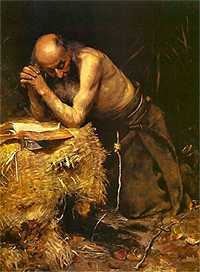  In
the Middle Ages men were encouraged to leave their wives and
families for years on end. When preaching the First Crusade,
Pope Urban II cited the words of Jesus from Matthew 10:37 and
19:29: "He that loveth father or mother more than me is
not worthy of me…every one that hath forsaken houses,
or brethren, or sisters, or father, or mother, or wife, or children,
or lands, for my name's sake, shall receive an hundredfold,
and shall inherit everlasting life". Pope Innocent III
made explicit the right of husbands to go off without their
wives" permission: men could abandon their families without
a word of explanation, emulating Jesus" early disciples.
Preachers lured many hundreds of thousands of men away from
their families to take the cross. When St Bernard preached,
women went in fear. Mothers hid their sons from him, wives their
husbands, and companions their friends. Bernard proudly informed
the Pope of his success in extracting men from their families
"I opened my mouth; I spoke; and at once the crusaders
have multiplied to infinity. Villages and towns are now deserted.
You will scarcely find one man for every seven women. Everywhere
you will see widows whose husbands are still alive2.
Most of those women were soon to become real widows3. In
the Middle Ages men were encouraged to leave their wives and
families for years on end. When preaching the First Crusade,
Pope Urban II cited the words of Jesus from Matthew 10:37 and
19:29: "He that loveth father or mother more than me is
not worthy of me…every one that hath forsaken houses,
or brethren, or sisters, or father, or mother, or wife, or children,
or lands, for my name's sake, shall receive an hundredfold,
and shall inherit everlasting life". Pope Innocent III
made explicit the right of husbands to go off without their
wives" permission: men could abandon their families without
a word of explanation, emulating Jesus" early disciples.
Preachers lured many hundreds of thousands of men away from
their families to take the cross. When St Bernard preached,
women went in fear. Mothers hid their sons from him, wives their
husbands, and companions their friends. Bernard proudly informed
the Pope of his success in extracting men from their families
"I opened my mouth; I spoke; and at once the crusaders
have multiplied to infinity. Villages and towns are now deserted.
You will scarcely find one man for every seven women. Everywhere
you will see widows whose husbands are still alive2.
Most of those women were soon to become real widows3.
|
Edmund Blair Leighton, The Dedication,
1908
An idealised version of a knight dedicating his sword
to God at the Church alter,
before riding off to the Crusades and leaving his wife
a widow.
|
|
|
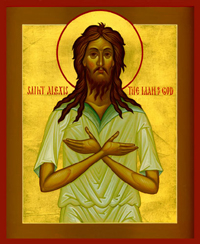  Back
at home the Church remained in control of family matters. People
were expected to put their Christian duties before their family
duties and inform on any deviation from orthodoxy. Back
at home the Church remained in control of family matters. People
were expected to put their Christian duties before their family
duties and inform on any deviation from orthodoxy.
Under Christian hegemony slaves
were not entitled to a family life either. They required permission
to marry. As chattels, some Christians held that they had no
right to marry at all. How could they if they had no souls,
and were not therefore fully human. In any case, slave families
could be split up, parents separated from their children, fathers
from mothers, brothers and sisters from their siblings. Even
in nineteenth century America the children of slaves were taken
from their parents before reaching their first birthday. Christianity
did not accord any value at all to family life per se.
When the Church wished a man dead it extended its ire to his
family, asking God to condemn his assets and so ruin his family
without regard to their guilt or innocence. The Church evinced
no sympathy at all for the family. Here for example is an extract
from a fairly typical text of excommunication, asking God to
create orphans and widows:
We curse Arduino and his brother Amedeo, marauders and devastators
of God's Church; we curse every inhabitant of Ivrea who gave
them help and advice; may they be damned in the city, in the
fields, cursed be their properties and their lands and herds
and their animals, damned the place where they enter, and
they go out; may God send unto them hunger and pestilence:
may they be damned, vigilants, travellers, sleepers, resters.
May God afflict them with misery, fever, hard frost, scorching
heat, infirmity until death. May delirium, blindness, madness,
fury afflict them at all times, that their children may become
orphans and their wives widows soon4.
Christian Practices from the Reformation
In the sixteenth and seventeenth centuries, priests assured
Roman Catholic women that they owed a greater duty to the Church
than to their husbands. For example they had a duty to help
priests wanted for treason even if their husbands did not approve
— even though by so doing they put their innocent husbands
at risk of death. Father Henry Garnet's Treatise of Christian
Renunciation contained many helpful examples of families
broken asunder by religious differences5.
Once again the point was clear: families were dispensable.
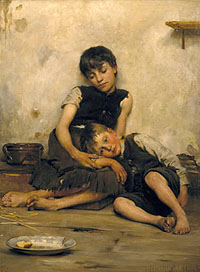  The
Catholic Church had insisted on clerical celibacy (not clerical
chastity) for those in Holy Orders explicitly so that the Church
would retain its assets and would not be responsible for maintaining
the widows and orphans of dead priests. Protestant Churches,
aware that there was no theological justification for prohibiting
clerical marriage, found an alternative solution to the problem.
They allowed clerical marriage, but simply turned clerical widows
and orphans out of their houses when a priest or minister died.
No alternative accommodation was provided, nor any pension,
nor any other sort of support, so that widows and orphans were
liable to die of exposure or starvation, as many did. It was
this scandalous abuse that led to the growth of insurance funds
such as the Ministers" Widows" Fund in the
mid eighteenth century6.,
followed by insurance companies such as Scottish Widows
in the nineteenth Century. Clerical Medical was another
such company, formed a few years after Scottish Widows.
Churches could easily have been running their own schemes for
centuries, but had perceived no moral duty to support hard-pressed
clerical families any more than any other destitute families.
On the contrary, Churches sought to prohibit, or at least discourage,
all forms of insurance. (For all mainstream Churches, life insurance
was a work of the Devil. Its purpose was to ameliorate the effects
of Acts of God, since God alone determined who should live and
who should die.) The
Catholic Church had insisted on clerical celibacy (not clerical
chastity) for those in Holy Orders explicitly so that the Church
would retain its assets and would not be responsible for maintaining
the widows and orphans of dead priests. Protestant Churches,
aware that there was no theological justification for prohibiting
clerical marriage, found an alternative solution to the problem.
They allowed clerical marriage, but simply turned clerical widows
and orphans out of their houses when a priest or minister died.
No alternative accommodation was provided, nor any pension,
nor any other sort of support, so that widows and orphans were
liable to die of exposure or starvation, as many did. It was
this scandalous abuse that led to the growth of insurance funds
such as the Ministers" Widows" Fund in the
mid eighteenth century6.,
followed by insurance companies such as Scottish Widows
in the nineteenth Century. Clerical Medical was another
such company, formed a few years after Scottish Widows.
Churches could easily have been running their own schemes for
centuries, but had perceived no moral duty to support hard-pressed
clerical families any more than any other destitute families.
On the contrary, Churches sought to prohibit, or at least discourage,
all forms of insurance. (For all mainstream Churches, life insurance
was a work of the Devil. Its purpose was to ameliorate the effects
of Acts of God, since God alone determined who should live and
who should die.)
|
Anti-Slavery Almanac, 1840, Published
in Boston by Western & Southard
Christian slave owners - buyers and sellers as well as
auctioneers -
were happy to divide slave families, including nursing
mothers from their infants.
|
|
|
The text continues: "Prof Andrews,
late of the University of N C in his recent work on
Slavery and the Slave Trade, p 147, relates the foregoing
conversation with a slave-trader on the Potomac".
Prof Andrews is William L. Andrews, of the University
of North Carolina, Editor of "The Literature of
Slavery and Freedom,"
|
Knobstick Weddings. A knobstick wedding is the forced
marriage of a pregnant single woman with the man believed to
be the father. It derives its name from the knobsticks or staves
of office carried by the church wardens since churchwardens
generally enforced such marriages. The practice and the term
were prevalent in the United Kingdom in the 18th century. Motivation
for knobstick weddings was primarily financial since local parishes
were obliged to provide relief for single mothers. Local authorities
therefore encouraged the woman to enter into a marriage with
the person presumed to be the father in an attempt to reduce
their spending and shift the responsibility to the man concerned.
On occasion the parish would pay a man to marry a pregnant girl.
There are also accounts of more aggressive tactics, including
threats to hang him. Since such practices were acceptable to
the Church, a secular equivalent, known as "shotgun weddings",
later became common - well into the twentieth century.
  For
well over a millennium and a half, Christians do not seem to
have recognised any moral obligation to keep families together.
When the British authorities decided to deport French Arcadians
from Canada in 1755, they called all the men to St Charles Church
in the village of Grand-Pré. There they were held and
promised that there women and children would sail with them,
while secret orders were given to Colonel Robert Monckton that
the men should be shipped off without them. The Arcadians were
treated appallingly, yet no one seems to have considered any
aspect of it unchristian, including the breaking up of families. For
well over a millennium and a half, Christians do not seem to
have recognised any moral obligation to keep families together.
When the British authorities decided to deport French Arcadians
from Canada in 1755, they called all the men to St Charles Church
in the village of Grand-Pré. There they were held and
promised that there women and children would sail with them,
while secret orders were given to Colonel Robert Monckton that
the men should be shipped off without them. The Arcadians were
treated appallingly, yet no one seems to have considered any
aspect of it unchristian, including the breaking up of families.
Christian Practices into Modern Times
  Children,
even Christian Children,
were not entitled to a family life either. Devout couples would
traditionally give at least every tenth child to the Church
as a sort of tithe, normally at the age of eight. Parents dedicated
their young boys to monasteries. These "oblates" were
brought up away from their families, by monks, for the service
of the Church, never to know a normal family life. Such children
had no say in the matter. Devout parents or guardians simply
gave away their children. The Benedictine order required a written
petition from parents or guardians who gave them their boys.
A boy's petition would be tied to his hand with an altar cloth
when he was presented to the monastic community6a. Children,
even Christian Children,
were not entitled to a family life either. Devout couples would
traditionally give at least every tenth child to the Church
as a sort of tithe, normally at the age of eight. Parents dedicated
their young boys to monasteries. These "oblates" were
brought up away from their families, by monks, for the service
of the Church, never to know a normal family life. Such children
had no say in the matter. Devout parents or guardians simply
gave away their children. The Benedictine order required a written
petition from parents or guardians who gave them their boys.
A boy's petition would be tied to his hand with an altar cloth
when he was presented to the monastic community6a.
Girls were also tithed, and countless thousands disappeared
into nunneries, along with their marriage dowries. Saint Hildegard
of Bingen tells us herself that she was one such child-tithe.
At the age of fourteen, girls given away in this way to become
nuns underwent a sort of mock death similar to the one the Church
inflicted on lepers
and criminals condemned
to death: victims were made to lie in a coffin, wrapped
in a shroud, while a burial service was conducted and prayers
said for the dead. The girls were then resurrected with a new
identity and immediately married to Jesus, after which, as a
Bride of Christ, they lived with their new family of
Mother, Father and Sisters, and polygamous absentee husband.
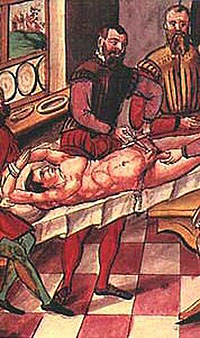  Another
indication of the Church's commitment to family life is provided
by the practice of surgically removing boys" testicles,
denying them the chance to become husbands or fathers. After
girls had been excluded from church choirs, the Eastern Churches
hit upon the idea of using castrated boys to replace falsetto
soprano voices. The idea was copied in Italy and Spain in the
sixteenth century. Countless tens of thousands of boys, perhaps
hundreds of thousands, were castrated for the pleasure of Orthodox
and Catholic churchmen. Popes and Church synods declined to
prohibit castration on the grounds that without castrati churches
would remain empty. So it was that castrati were entertaining
popes in the Sistine chapel into the twentieth century. It was
of absolutely no consequence that these boys, when they reached
adulthood, were denied the possibility of an ordinary family
life. Obviously they could not father children, but Christianity
would not even allow them to become husbands, as some castrati
wanted to. The Church would not allow them to marry precisely
because they could not father children. It was much more important
that clerics should be able to hear high-pitched male singing
voices than that men should have normal family lives. The practice
has stopped now, the last castrato to sing officially at St
Peter's having died in the 1920s, though there may have been
private performances into the 1950s. Subsequent popes have refused
to apologise for the role of the papacy, apparently because
they feel they have nothing to apologise for8. Another
indication of the Church's commitment to family life is provided
by the practice of surgically removing boys" testicles,
denying them the chance to become husbands or fathers. After
girls had been excluded from church choirs, the Eastern Churches
hit upon the idea of using castrated boys to replace falsetto
soprano voices. The idea was copied in Italy and Spain in the
sixteenth century. Countless tens of thousands of boys, perhaps
hundreds of thousands, were castrated for the pleasure of Orthodox
and Catholic churchmen. Popes and Church synods declined to
prohibit castration on the grounds that without castrati churches
would remain empty. So it was that castrati were entertaining
popes in the Sistine chapel into the twentieth century. It was
of absolutely no consequence that these boys, when they reached
adulthood, were denied the possibility of an ordinary family
life. Obviously they could not father children, but Christianity
would not even allow them to become husbands, as some castrati
wanted to. The Church would not allow them to marry precisely
because they could not father children. It was much more important
that clerics should be able to hear high-pitched male singing
voices than that men should have normal family lives. The practice
has stopped now, the last castrato to sing officially at St
Peter's having died in the 1920s, though there may have been
private performances into the 1950s. Subsequent popes have refused
to apologise for the role of the papacy, apparently because
they feel they have nothing to apologise for8.
|
Commercial
Recording
|
Alessandro Moreschi
The last official Vatican Castrato
|
|
|
|
The hereditarily sick were also regarded as less than deserving
of family life. Historically, sickly
Christian children had been discretely killed, a practice
justified by regarding them as changelings, and not therefore
human.
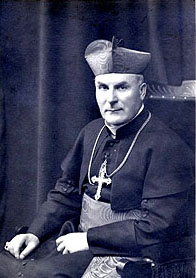  By
the twentieth century, this was no longer acceptable, and more
acceptable alternatives were sought. When Hitler discussed them
with Cardinal Faulhaber in 1936 the two men had different approaches
to the problem. Hitler wanted to sterilise them, but the cardinal
had another solution: "The state, Herr Reich-chancellor,
is not debarred from removing these vermin from the national
community in the interests of legitimate self-defence and in
conformity with moral law, but preventives other than physical
mutilation must be sought, and such a preventive does exist:
the internment of the hereditary sick"9.
He was talking about what we now call concentration camps. By
the twentieth century, this was no longer acceptable, and more
acceptable alternatives were sought. When Hitler discussed them
with Cardinal Faulhaber in 1936 the two men had different approaches
to the problem. Hitler wanted to sterilise them, but the cardinal
had another solution: "The state, Herr Reich-chancellor,
is not debarred from removing these vermin from the national
community in the interests of legitimate self-defence and in
conformity with moral law, but preventives other than physical
mutilation must be sought, and such a preventive does exist:
the internment of the hereditary sick"9.
He was talking about what we now call concentration camps.
The cardinal's problem with sterilisation was that it would
allow people to enjoy sex without the risk of procreation. Sterilisation
was a form of contraception,
and therefore contrary to the teaching of the Roman Church.
Contraception was morally unacceptable, but there was nothing
wrong with splitting up families in order to put the sick into
concentration camps.
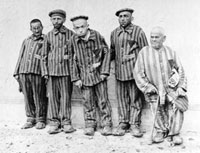  Anglican
attitudes to the importance of family unity had been similar
a couple of generations earlier, even for healthy families.
In Victorian times parochial charities found it perfectly consistent
with Christian teachings to split up poor
families when families claimed poor relief. Husbands would
be sent to one poor house, wives to another, and children perhaps
to a third. Untold numbers of married couples were split up,
never to see each other or their children again. Anglican
attitudes to the importance of family unity had been similar
a couple of generations earlier, even for healthy families.
In Victorian times parochial charities found it perfectly consistent
with Christian teachings to split up poor
families when families claimed poor relief. Husbands would
be sent to one poor house, wives to another, and children perhaps
to a third. Untold numbers of married couples were split up,
never to see each other or their children again.
|
Women in a workhouse.
Many of these women would have been separated from their
husbands and families
|
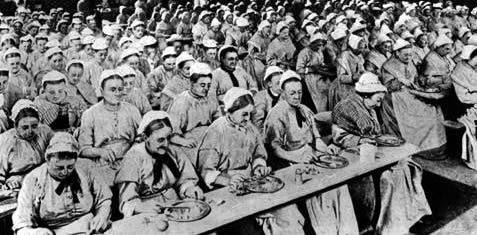 |
|
|
|
Men in a workhouse.
Many of these men would have been separated from their
wives and families
|
|
|
|
|
|
Photograph of boys at Crumpsall Workhouse,
Manchester, England, c 1895
Many of these boys would have been separated from their
parents and sisters
|
|
|
Christian Kidnapping of Children
  When
Christian missionaries failed to make an impact on the local
population, they would sometimes kidnap local children and dedicate
them to God, even though their families needed these children.
By force or deception the children would have their heads shaved,
as a symbol of their dedication to the Christian God. A missionary
called Symeon pioneered this around the Euphrates in the sixth
century, scorning the objections of the villagers whose children
he had shorn. Those who objected died in mysterious circumstances,
and the rest gave way. When
Christian missionaries failed to make an impact on the local
population, they would sometimes kidnap local children and dedicate
them to God, even though their families needed these children.
By force or deception the children would have their heads shaved,
as a symbol of their dedication to the Christian God. A missionary
called Symeon pioneered this around the Euphrates in the sixth
century, scorning the objections of the villagers whose children
he had shorn. Those who objected died in mysterious circumstances,
and the rest gave way.
The abduction and indoctrination of children
became a standard technique when missionaries could make no
impact on adults, and would be used with effect for many centuries.
Children of members of any other faith might be seized by Christian
authorities. Sometimes whole families were seized. During the
seventeenth and eighteenth centuries Jewish families were taken,
often by force, by Christian authorities and subjected to what
we would now call brainwashing. If some of the family converted
and some did not, they were split up, never to see each other
again. Sometimes husbands never saw their wives again, sometimes
parents never saw their children again.
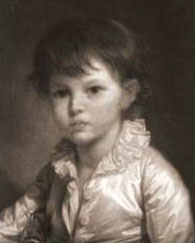  As
late as 1858, acting under clerical instructions, the Bologna
police seized a young Jewish boy, Edgardo
Mortara. Despite an international outcry the kidnapped boy was
kept in Rome by the Roman Catholic Church and "re-educated".
His re-education was so successful that he became a missionary
priest. From the age of seven until his death he was never to
know a proper family, either as son, brother or father7. As
late as 1858, acting under clerical instructions, the Bologna
police seized a young Jewish boy, Edgardo
Mortara. Despite an international outcry the kidnapped boy was
kept in Rome by the Roman Catholic Church and "re-educated".
His re-education was so successful that he became a missionary
priest. From the age of seven until his death he was never to
know a proper family, either as son, brother or father7.
Removing converts from their families in order to discourage
apostasy was extremely common. Indeed it was standard practice,
and still is among many Christian missionary groups. Converts
are transplanted to another community, often to another country,
so that they have to depend upon their new Church family rather
than their real family. Converts are routinely moved away from
families of practising Jews
or Moslems, and from family members that the Church consider
heathen, heretical,
schismatic,
freethinking, rationalist,
apostate,
humanist,
pantheist,
Unitarian,
Deist, agnostic,
atheist or even merely secular.
With the complicity of the state Christians have been kidnapping
non-Christian children well into the twentieth century in order
to indoctrinate them. This practice is generally justified by
claiming that non-Christian parents are somehow unsuitable.
In the nineteenth century and into the twentieth century, African
children were routinely removed from their families and placed
in Christian missions or orphanages to be raised as Christians.
With a suitable education they could then be used as colonial
soldiers with no qualms about flogging, torturing, mutilating
or killing their fellow Africans. Children raised in Catholic
orphanages were brutalised and given basic military training
to became members of the Force Publique in the Belgian
Free State. Having been themselves brutalised, they provided
a useful resource for carrying out further atrocities, flogging,
torturing, mutilating or killing men women and children on the
orders of officers and on their own initiative.
|
Nsala, of the district of Wala in the
Congo Free State
He is looking at the severed hand and foot of Boali, his
five-year old daughter
Source: E. D Morel, King Leopold's Rule in Africa,
pp 144-5
Atrocities like this were committed routinely by the Force
Publique
|
|
|
For more on child abuse in the Congo Free State, and the role
of the Christian Churches, see Christian
atrocities.
Native American children were being taken from their families
by the Canadian authorities until at least the 1950s. Aboriginal
children were being taken from their families by the Australian
authorities until the 1960s and put into Christian orphanages.
|
Extract from the first page of an Australian
Government report, published in 1997
|
|
|
As in so many other areas, the Nazis had adopted and extended
traditional Christian practices with regard to children. Nazis
kidnapped children and indoctrinated them, just as the Catholic
Church had done for centuries. In some cases, churches were
used to facilitate the Nazi process. From 1940, Nazi agencies
became responsible for the selection of children in occupied
countries whom they thought could be 'Germanized' by placing
them in German homes. In Poland these children were kidnapped
from their own homes and from orphanages. In some cases they
were torn from the arms of their mothers on the street. Any
child with fair hair, blue eyes, or who 'looked Aryan' was liable
to be seized. Some reception centres for selection and racial
testing of these children were set up in religious establishments
such as the monastery at Kalisz in Poland. Once in these homes
the children were forbidden to speak Polish, instead were drilled
in German before being sent to Germany, now bearing the names
of their designated foster parents. Fraudulent birth certificates
and genealogies were invented for the children. More than 200,000
children were kidnapped in Poland by the SS and the Brown Sisters
(the NSV, the female counterpart of the SA).
the practice was not confined to Poland. Between 40,000 and
50,000 children were kidnapped in Russia, and in the Hungarian
Ukraine another 50,000 were kidnapped. Children under six years
of age were adopted out to suitably Aryan German families who
were told that the children's parents had been killed in air
raids. Children who failed to pass tests were sent Kalisz or
Auschwitz, to disappear without trace.
A Roman Catholic organisation in Switzerland was kidnapping
Romany children
and sending them to be adopted by Catholic families well into
the 1970s10.
The children were routinely told that their parents were dead,
and that they had no living relatives. The same thing was common
amongst the children of unmarried mothers around the world —
from New Zealand to Ireland and Brazil. Children were taken
by force, with the complicity of the authorities, and given
up for adoption as "orphans" to right-thinking Christians.
The family unit was of no consequence.
As in other Christian countries, in Catholic Ireland Church
and state conspired to punish single mothers for their supposed
sin. Mothers were put into the care of nuns in "mother
and baby homes" or in Magdelene Laundries. Babies were
removed from their "sinful" mothers and both were
punished for their sin. Some of these children were shipped
off, illegally, by nuns for adoption by Catholic families, often
in the USA. Others stayed in homes, separated from their mothers,
treated as orphans full of sin, where they were routinely abused,
physically, mentally and sexually. Many died at the hands of
nuns, either of neglect or harsh treatment. Mortality rates
were many times higher than in the population at large. In one
mother and baby home, run by the Bon Secours nuns at
Tuam, County Galway, between 1925 and 1961, the bodies of some
796 dead children were dumped in a sewage tank10a.
The sinful children had not apparently merited a Christian burial.
|
Sean Ross Abbey south of Roscrea in County
Tipperary, Ireland is a convent and the location of St
Anne’s Special School run by the Sisters of the Sacred
Hearts of Jesus and Mary. A "mother and baby home"
operated here from 1930 to 1970. Babies born in the home
were put up for adoption, many of them in the USA. The
graves of an unknown number of mothers and babies are
located in the unmarked area. Some 438 babies were secretly
exported from Sean Ross Abbey to the US for adoption.
|
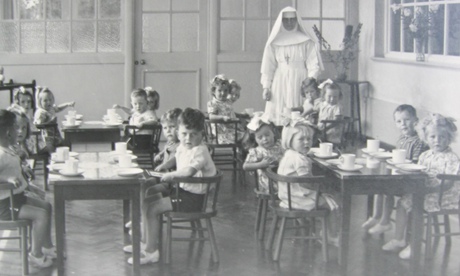 |
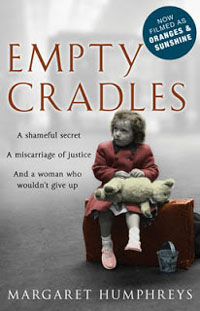  In
Britain children were not taken by force, but the effect was
much the same. Stigmatised single mothers often left their children
with Christian organisations, either to be adopted or to be
cared for until the mother could take the child back. Many of
these organisations sent children to the colonies without their
parents' knowledge or consent — even when the mothers had
stated explicitly that they would return to take their children
back11. The
children were told falsely that their parents were dead12.
They were described as orphans and grew up believing
themselves to be orphans in the usual sense of the word13.
They were not given their birth certificates or other identification
documentation. Sometimes they were given new names and birthdays.
Sometimes their files were burned14.
In some cases when parents came back to reclaim their children
they were told, again falsely, that the children were dead15.
Even when they were told the truth, no effort was made to bring
the children back16.
The people involved seemed to have no qualms about separating
children from their natural parents. When Monsignor George Crennan,
a former director of the Australian Federal Catholic Immigration
Committee, was asked if he felt he had any responsibility to
children who wanted to trace their families he replied "Most
certainly not"17. In
Britain children were not taken by force, but the effect was
much the same. Stigmatised single mothers often left their children
with Christian organisations, either to be adopted or to be
cared for until the mother could take the child back. Many of
these organisations sent children to the colonies without their
parents' knowledge or consent — even when the mothers had
stated explicitly that they would return to take their children
back11. The
children were told falsely that their parents were dead12.
They were described as orphans and grew up believing
themselves to be orphans in the usual sense of the word13.
They were not given their birth certificates or other identification
documentation. Sometimes they were given new names and birthdays.
Sometimes their files were burned14.
In some cases when parents came back to reclaim their children
they were told, again falsely, that the children were dead15.
Even when they were told the truth, no effort was made to bring
the children back16.
The people involved seemed to have no qualms about separating
children from their natural parents. When Monsignor George Crennan,
a former director of the Australian Federal Catholic Immigration
Committee, was asked if he felt he had any responsibility to
children who wanted to trace their families he replied "Most
certainly not"17.
|
In 1947 the SS Asturias took the first
post-war child immigrants to Australia
|
|
|
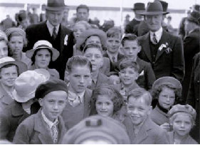  Sometimes
two or more brothers and sisters might be sent out at the same
time. Usually they were split up — destroying the last
vestige of a family relationship. In 1956 a secular government-appointed
body recommended that this practice should cease18.
Even so, these children were to remain in institutions throughout
their childhoods. Even when families came forward to foster
children, traditionalist Churches preferred to keep them in
orphanages, demonstrating once again their commitment to family
life. An official report in Western Australia in 1959 indicated
that "practically all children could be adequately fostered
if the institutions were not loath to part with them19.
When offers had been made to adopt children in Roman Catholic
orphanages, the answer had been the same20.
The children were not available for adoption and would spend
their whole childhoods in Church institutions. The Roman Catholic
Church was active in encouraging child migration21.
It had an interest in encouraging children to be sent to overseas
orphanages, and looked for ways to increase their intake. In
December 1954 a request was made to the Australian government
by the Roman Catholic Church to reduce the minimum age of child
migrants from 5 to 3. By now the Churches were finding it difficult
to fill their beds. The last child migrations to Australia took
place in 1967. By then between 100,000 and 150,000 children
had been shipped around the world, away from their roots and
their relatives. The practice was stopped not by the receiving
institutions, but by the authorities in Britain who were becoming
ever more aware of the type of future awaiting child migrants.22 Sometimes
two or more brothers and sisters might be sent out at the same
time. Usually they were split up — destroying the last
vestige of a family relationship. In 1956 a secular government-appointed
body recommended that this practice should cease18.
Even so, these children were to remain in institutions throughout
their childhoods. Even when families came forward to foster
children, traditionalist Churches preferred to keep them in
orphanages, demonstrating once again their commitment to family
life. An official report in Western Australia in 1959 indicated
that "practically all children could be adequately fostered
if the institutions were not loath to part with them19.
When offers had been made to adopt children in Roman Catholic
orphanages, the answer had been the same20.
The children were not available for adoption and would spend
their whole childhoods in Church institutions. The Roman Catholic
Church was active in encouraging child migration21.
It had an interest in encouraging children to be sent to overseas
orphanages, and looked for ways to increase their intake. In
December 1954 a request was made to the Australian government
by the Roman Catholic Church to reduce the minimum age of child
migrants from 5 to 3. By now the Churches were finding it difficult
to fill their beds. The last child migrations to Australia took
place in 1967. By then between 100,000 and 150,000 children
had been shipped around the world, away from their roots and
their relatives. The practice was stopped not by the receiving
institutions, but by the authorities in Britain who were becoming
ever more aware of the type of future awaiting child migrants.22
As middle-aged adults, many of these "orphans" discovered
in the 1980s that they were not orphans at all. Some parents
discovered that their children were not dead, as they had been
told. The emotional turmoil caused by this "deceit and
deception" was documented by Margaret Humphreys, the woman
who discovered and exposed what had happened23.
Similar practices existed in Australia for the babies of Australian
single mothers, as they did in other countries. In the USA,
New Zealand, Canada and Ireland, as well in Britain and Australia,
for over fifty years, new born babies were effectively stolen
by the authorities, or with the complicity of the authorities.
Since Christian societies regarded single mothers as sinful
and inadequate their babies were routinely handed over to Christian
institutions. Sometimes the removal was accomplished by social
pressure, sometimes illegally by deception, forgery or fraud.
In some cases the babies were brought up as orphans in Christian
orphanages. In others they were adopted by respectable couples
who could be relied upon to bring them up in the Christian faith.
They would be given new identities so that they could never
find their natural parents. If the distraught mother made a
fuss, she could be committed to a mental institution. She was
by definition a sinner and an inadequate mother. Church institutions
were involved throughout - from the local church, to the Christian
maternity home, to the Church orphanage, and the Church adoption
agency. This practice of "forced adoption" is also
known as "baby scooping". In Australia, the victims
are called the "White Stolen Generations" to distinguish
them from aboriginal victims, the "Black Stolen Generations"
- who were not necessarily the babies of single mothers (aboriginal
children were kidnapped at any age from families that were not
sufficiently Christian). The Baby Scoop Era ended in the 1970s
or 1980s, as the Churches lost influence and contraception became
popular.
From approximately 1940 to 1970, some 4 million mothers in
the United States alone surrendered newborn babies to adoption,
around 2 million during the 1960s alone. The overwhelming majority
would have been "forced adoptions"
|
Sister Marie Carmine with orphans at
the St. John’s Orphan Asylum
West Philadelphia, USA, 1950s - but were these"orphans"
really orphans?
|
|
|
In 2013 the Australian Government apologised for its role in
forced adoption, referring to it as the "cruel, immoral
practice of forced adoption". As the government apology
pointed out, churches, charities and others had struck at "the
most primal and sacred bond there is: the bond between a mother
and her baby". Of the mothers it said "Too often they
did not see their baby's face. They couldn't sooth his first
cries. Never felt her warmth or smelt her skin. They could not
give their own baby a name"
|
Extracts from a National Apology for
Forced Adoptions made on Thursday 21 March 2013,
by Julia Gillard, Prime Minister of Australia.
You can read the full
text of the apology at the bottom of this page.
None of the Churches, who were at least as culpable, have
made a comparable apology.
|
|
... Today, this Parliament,
on behalf of the Australian people, takes responsibility
and apologises for the policies and practices that
forced the separation of mothers from their babies,
which created a lifelong legacy of pain and suffering.
.... We deplore the shameful
practices that denied you, the mothers, your fundamental
rights and responsibilities to love and care for
your children. You were not legally or socially
acknowledged as their mothers. And you were yourselves
deprived of care and support.
.... To you, the mothers
who were betrayed by a system that gave you no choice
and subjected you to manipulation, mistreatment
and malpractice, we apologise.
.... We say sorry to you,
the mothers who were denied knowledge of your rights,
which meant you could not provide informed consent.
You were given false assurances. You were forced
to endure the coercion and brutality of practices
that were unethical, dishonest and in many cases
illegal.
.... We know you have suffered
enduring effects from these practices forced upon
you by others. For the loss, the grief, the disempowerment,
the stigmatisation and the guilt, we say sorry.
.... To each of you who were
adopted or removed, who were led to believe your
mother had rejected you and who were denied the
opportunity to grow up with your family and community
of origin and to connect with your culture, we say
sorry.
.... We apologise to the
sons and daughters who grew up not knowing how much
you were wanted and loved.
... We are saddened that
many others are no longer here to share this moment.
In particular, we remember those affected by these
practices who took their own lives. Our profound
sympathies go to their families.
... We resolve, as a nation,
to do all in our power to make sure these practices
are never repeated. In facing future challenges,
we will remember the lessons of family separation.
Our focus will be on protecting the fundamental
rights of children and on the importance of the
child's right to know and be cared for by his or
her parents.
... A story of suffering
and unbearable loss.
... This story had its beginnings
in a wrongful belief that women could be separated
from their babies and it would all be for the best.
Instead these churches and
charities, families, medical staff and bureaucrats
struck at the most primal and sacred bond there
is: the bond between a mother and her baby.
... For the most part, the
women who lost their babies were young and vulnerable.
They were often pressurised
and sometimes even drugged.
They faced so many voices
telling them to surrender, even though their own
lonely voice shouted from the depths of their being
to hold on to the new life they had created.
Too often they did not see
their baby's face.
They couldn't sooth his first
cries.
Never felt her warmth or
smelt her skin.
They could not give their
own baby a name.
Those babies grew up with
other names and in other homes.
Creating a sense of abandonment
and loss that sometimes could never be made whole.
... children were wrenched
away so soon after birth.
... In institutions around
Australia, women were made to perform menial labour
in kitchens and laundries until their baby arrived.
... As the time for birth
came, their babies would be snatched away before
they had even held them in their arms.
Sometimes consent was achieved
by forgery or fraud.
Sometimes women signed adoption
papers while under the influence of medication.
Most common of all was the
bullying arrogance of a society that presumed to
know what was best.
... For so many children of
forced adoption, the scars remain in adult life.
... But by saying sorry we
can correct the historical record.
We can declare that these
mothers did nothing wrong.
That you loved your children
and you always will.
And to the children of forced
adoption, we can say that you deserved so much better.
You deserved the chance to
know, and love, your mother and father.
... The cruel, immoral practice
of forced adoption will have no place in this land
any more.
|
|
In other countries the sheer inhumanity was even worse. In
Spain for example Catholic nuns stole new born babies in hospitals,
telling the mothers that their babies had been stillborn, and
then selling the babies to infertile Catholic couples who could
afford "the price of a small flat".24
The same thing happened in Catholic countries in South America.
In Quebec it was even worse. Canadian Orphanages and schools
were the financial responsibility of the provincial government
but funding for mental institutions was provided by the federal
government. This gave a financial incentive for provincial governments
to identify orphans as mentally defective. From the 1940s into
the 1960s, Quebec Premier Maurice Duplessis and the Roman Catholic
Church (which ran the orphanages) developed a scheme to obtain
federal funding for thousands of children. Most of these children
were not really orphans - they had been "orphaned"
through forced removal from their unmarried mothers. In some
cases perfectly normal "orphans" were sent to mental
institutions. In other cases Catholic orphanages were reclassified
as health-care facilities. The children suffered the usual range
of abuse in Catholic institutions at the hands of nuns and priests:
physical, sexual and mental, but even this was not all. Some
of the children were used in medical experiments, obviously
without any consent other than that of their Catholic guardians.
In the 1990s, 3,000 or so survivors formed a group of "Duplessis
Orphans" to start a campaign to publicise what had happened
to them. In 2004 the "Duplessis Orphans" asked the
Quebec government to excavate an abandoned cemetery at the east
end of Montreal. They claimed that the cemetery contained the
bodies of "orphans" who had been the subjected to
medical experiments. According to testimony by individuals had
been at the Cité de St-Jean-de-Dieu insane asylum, the
orphans were routinely experimented upon and many died. A Quebec
law passed in 1942 had allowed the nuns to sell unclaimed bodies
to medical schools for $10. In 2002, a group of 1,100 orphans
settled with the provincial government for about $25-million
for wrongfully placing them in mental institutions. The Catholic
Church has not apologized, and the terms of the financial settlement
precludes action against the Church24a
|
In Canada, residential schools did significant
harm to Aboriginal children by removing them from their
families, depriving them of their ancestral languages,
sterilizing them, and exposing many of them to physical
and sexual abuse. This consensus was symbolized by the
June 11, 2008 public apology offered, by Prime Minister
Stephen Harper on behalf of the Government of Canada,
and also by the leaders of all the other parties in the
Canadian House of Commons.
Some 150,000 First Nations children passed through the
Canadian residential school system, operated by various
Churches, mainly Catholic and Anglican.
This photo shows victims at the Canadian Indian Industrial
School c1890
|
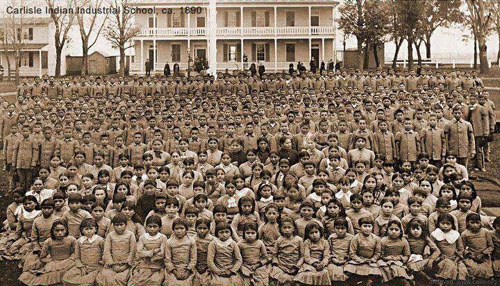 |
The practice of stealing children continued into the twenty-first
century, revealed for example by the Arche de Zoë25
(“Zoë's Ark”) scandal of late 2007. French
volunteers “on a mission” were charged with kidnapping
103 children in Chad, making out that the children were orphans26
and reviving memories of similar kidnappings carried out by
the Catholic Church under King Leopold of the Belgians in the
late nineteenth century27.
The accused had gone so far as to mock up wounds on the children
in order to justify their removal. As in King Leopold's time
most of the children were not orphans at all and had been taken
from their families by force or deceit. As the President of
Chad pointed out, some of the kidnap victims had been “torn”
from their Muslim families28.
Six people were convicted in Paris in February 2013.
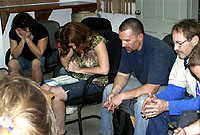  In
2010 ten American Baptists from Idaho, faced charges of criminal
conspiracy, kidnapping minors and child trafficking in Haiti.
Following a severe earthquake the Baptists had taken some 33
children, aged from two months to twelve years, mainly from
the mountain village of Callebasse. The Baptists had then tried
to take them out of the country passing them off as orphans
without official papers. The plan had been to take them to the
Dominican Republic, where the Baptists planned to have them
adopted by Christian (presumably Baptist) couples from the US.
At least half of the children knew perfectly well that they
were not orphans. The Baptists falsely claimed to have rescued
all the children from "an orphanage", but when CNN
turned up to investigate, they had no difficulty in finding
the parents of the "orphans". Some of the parents
had voluntarily handed over their children to the Baptists,
hoping they would give them a better life in the US. The Baptists
had watched tearful parents saying good-bye to their own sons
and daughters, before they took them anyway. Such was their
Christian concern for family life29.
A Dominican friar, Jorge Puello, who was also involved, was
found to be under investigation for sex trafficking in El Salvador. In
2010 ten American Baptists from Idaho, faced charges of criminal
conspiracy, kidnapping minors and child trafficking in Haiti.
Following a severe earthquake the Baptists had taken some 33
children, aged from two months to twelve years, mainly from
the mountain village of Callebasse. The Baptists had then tried
to take them out of the country passing them off as orphans
without official papers. The plan had been to take them to the
Dominican Republic, where the Baptists planned to have them
adopted by Christian (presumably Baptist) couples from the US.
At least half of the children knew perfectly well that they
were not orphans. The Baptists falsely claimed to have rescued
all the children from "an orphanage", but when CNN
turned up to investigate, they had no difficulty in finding
the parents of the "orphans". Some of the parents
had voluntarily handed over their children to the Baptists,
hoping they would give them a better life in the US. The Baptists
had watched tearful parents saying good-bye to their own sons
and daughters, before they took them anyway. Such was their
Christian concern for family life29.
A Dominican friar, Jorge Puello, who was also involved, was
found to be under investigation for sex trafficking in El Salvador.
Modern Christian concern for family life and family values
is anything but traditional. In the past families were split
up for countless reasons that suited the Church. We have seen
a few of them: separation from pagans, Jews, Moslems, even Christians
of the wrong denomination. People abandoning their families,
sometimes leaving their spouses on their wedding day, to devote
their lives to the Church. Children removed either by force,
or by social pressure. Children given up to be enclosed in Monasteries
and Nunneries. Boys castrated. Children taken by force or trickery
from slaves, from non-Christian families and even from poor
Christian families. Even now missionaries are breaking up families,
telling new converts to leave their pagan spouses, siblings,
parents and children, just as Christian missionaries have done
since Roman times.
|
For the Christian Church, the historical
ideal was lifelong celibacy. This unnatural state was
disguised by pretend marriages. Priests married the Church.
Nuns married Christ. Any sexual activity therefore constituted
not merely fornication but adultery.
This photograph is entitled "A Meeting
of the Brides of Christ on their Wedding Day to their
Lord at the Nunnery in Godalming, Surrey". It was,
taken at the Ladywell Convent and is one of a series on
the lives of nuns that Eve Arnold took during the mid-1960s.
It was bequeathed to the V&A in 2010.
|
|
|
| |
|
Mother Caroline-Marie helping a new novice
of the Institute of Christ the King with her bridal veil.
|
|
|
| |
|
Eve Arnold - A wedding cake for the Brides
of Christ, Surrey, England, 1965.
|
|
|
| |
| |
Families are only important when they serve Christian ends.
Otherwise they are dispensable. The current attachment to family
values, so popular in certain quarters, is an innovation, and
runs contrary to the historical stance of all mainstream Churches,
as academic theologians freely confirm. Don Cupitt put it most
clearly: "The idealisation of the family is a modern cultural
creation, which the Churches have validated, and now no modern
bishop would dream of publicly endorsing Jesus' views about
the family".
More social issues:
|
|
|
|
|
|
|
|
|
|
|
|
|
|
|
|
|
|
|
|
|
|
|
|
|
|
|
|
|
|
|
|
|
|
|
|
|
|
Buy the Book from Amazon.com
|
|
|
|
|
|
Buy the Book from Amazon.co.uk
|
|
|
| |
| |
| More Books |
|
|
|